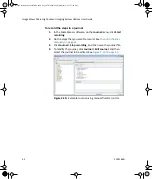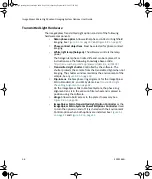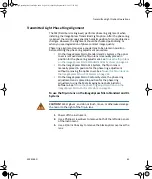
Fluidics Option Operations
5014166 D
49
Preventing Evaporation from Compound Plates
Incubation at elevated temperatures, such as 37°C, causes rapid
evaporation of water from aqueous compound preparations in storage
plates. DMSO-based preparations are hygroscopic and absorb water from
the surrounding air. To minimize these problems, seal the compound
storage plates with aluminum foil seals before placing them in the
environmental chamber. Foil seals can be pierced during the experiment
by the pipette tips on the fluidics robot, only exposing individual wells
after use.
Seals generally adhere better to plates with raised rings around the wells
than to plates with a smooth surface. Evaporation is greater from the
outer wells of a microplate, both from micro-environmental variations,
and because of poorer adhesion at the outer edges of the seal. It might
be preferable to omit these wells from experiments with long incubation
periods. It is also useful to set up the fluidics plate configuration on an
equivalent, unsealed plate before trying to pipette from a sealed plate.
Evaluated Seals
Molecular Devices has evaluated both heat-applied and pressure-applied
seals with a variety of polypropylene and polystyrene plates. Two
examples are listed here. Other manufacturers might provide similar
performance.
Heat-applied seals
Tomtec heat-applied aluminum foil seals
•
Part numbers: Tomtec AutoSeal instrument (710-100) and foil
seal material (AS-3)
•
For specifications, ordering information, pricing, and sealing
instructions, contact Tomtec (
•
Features
Automated robotic plate sealing
Suitable for polypropylene plates
Easily punctured by the fluidics robot using FLIPR Tetra
pipette tips
Compatible with DMSO
Easily peeled from the plate
ImageXpressOptionsUserGuide.book Page 49 Wednesday, September 9, 2015 3:54 PM
















































